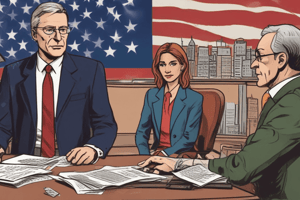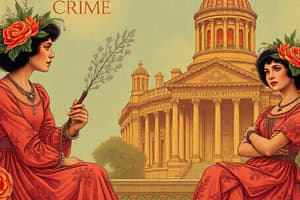Podcast
Questions and Answers
What type of crime involves the use or threat of force?
What type of crime involves the use or threat of force?
- Property crime
- Violent crime (correct)
- Cybercrime
- White-collar crime
Which term refers to serious physical or emotional harm?
Which term refers to serious physical or emotional harm?
- Incarnation
- Trauma (correct)
- Diversion
- Punishment
What does the term 'hot spotting' refer to in crime analysis?
What does the term 'hot spotting' refer to in crime analysis?
- Identifying areas with frequent crime (correct)
- Mapping out drug-related offenses
- Arresting individuals in high-crime areas
- Creating crime prevention strategies
Which act focused on taxing and restricting marijuana?
Which act focused on taxing and restricting marijuana?
Which of the following U.S. Presidents was a Republican?
Which of the following U.S. Presidents was a Republican?
What does 'mass incarnation' refer to?
What does 'mass incarnation' refer to?
Which concept refers to a belief that causes itself to become true?
Which concept refers to a belief that causes itself to become true?
What is the goal of criminal justice reform?
What is the goal of criminal justice reform?
Which law increased drug penalties in 1952?
Which law increased drug penalties in 1952?
What does the term 'prison industrial complex' refer to?
What does the term 'prison industrial complex' refer to?
What is the purpose of crime mapping?
What is the purpose of crime mapping?
What defines a reasonable solution in the context of legal and social issues?
What defines a reasonable solution in the context of legal and social issues?
What is the significance of Terry V Ohio in law enforcement?
What is the significance of Terry V Ohio in law enforcement?
What does the term 'self-fulfilling prophecy' imply in socio-legal contexts?
What does the term 'self-fulfilling prophecy' imply in socio-legal contexts?
The term 'disproportionate impact' refers to what?
The term 'disproportionate impact' refers to what?
What characterizes the 'Prison Industrial Complex'?
What characterizes the 'Prison Industrial Complex'?
What does the 'Marijuana Tax Act of 1937' primarily involve?
What does the 'Marijuana Tax Act of 1937' primarily involve?
What type of programs are categorized as 'pre-trial diversion'?
What type of programs are categorized as 'pre-trial diversion'?
Which of the following best describes 'ideological shift'?
Which of the following best describes 'ideological shift'?
What does 'stop and frisk' refer to in law enforcement practices?
What does 'stop and frisk' refer to in law enforcement practices?
What is the function of crime mapping in law enforcement?
What is the function of crime mapping in law enforcement?
Which term describes the practice of identifying areas with frequent criminal activity?
Which term describes the practice of identifying areas with frequent criminal activity?
What does 'punitive' primarily emphasize?
What does 'punitive' primarily emphasize?
What is mass incarceration primarily concerned with?
What is mass incarceration primarily concerned with?
What does the term 'ideological shift' imply?
What does the term 'ideological shift' imply?
Which act relates to stricter penalties for narcotics in 1956?
Which act relates to stricter penalties for narcotics in 1956?
What is referred to as the 'Prison Industrial Complex'?
What is referred to as the 'Prison Industrial Complex'?
What does pre-trial diversion aim to achieve?
What does pre-trial diversion aim to achieve?
What is the significance of the Boggs Act of 1952?
What is the significance of the Boggs Act of 1952?
What principle is established by Terry v. Ohio?
What principle is established by Terry v. Ohio?
Flashcards
Violent Crime
Violent Crime
A crime where someone uses or threatens force against another person or property.
Trauma
Trauma
Serious physical or emotional harm caused by a traumatic event.
Crime Mapping
Crime Mapping
Using maps to study crime locations, identifying patterns and hotspots.
Hot Spotting
Hot Spotting
Signup and view all the flashcards
Stop and Frisk
Stop and Frisk
Signup and view all the flashcards
Ideological Shift
Ideological Shift
Signup and view all the flashcards
Punitive
Punitive
Signup and view all the flashcards
Mass Incarceration
Mass Incarceration
Signup and view all the flashcards
Prison Industrial Complex
Prison Industrial Complex
Signup and view all the flashcards
Reasonable Solution
Reasonable Solution
Signup and view all the flashcards
Franklin D. Roosevelt
Franklin D. Roosevelt
Signup and view all the flashcards
Harry S. Truman
Harry S. Truman
Signup and view all the flashcards
Dwight D. Eisenhower
Dwight D. Eisenhower
Signup and view all the flashcards
John F. Kennedy
John F. Kennedy
Signup and view all the flashcards
Lyndon B. Johnson
Lyndon B. Johnson
Signup and view all the flashcards
Richard Nixon
Richard Nixon
Signup and view all the flashcards
Gerald Ford
Gerald Ford
Signup and view all the flashcards
Jimmy Carter
Jimmy Carter
Signup and view all the flashcards
Ronald Reagan
Ronald Reagan
Signup and view all the flashcards
Marijuana Tax Act of 1937
Marijuana Tax Act of 1937
Signup and view all the flashcards
What was the purpose of the Marijuana Tax Act of 1937?
What was the purpose of the Marijuana Tax Act of 1937?
Signup and view all the flashcards
What is 'mass incarceration'?
What is 'mass incarceration'?
Signup and view all the flashcards
How might the 'Prison Industrial Complex' be harmful?
How might the 'Prison Industrial Complex' be harmful?
Signup and view all the flashcards
What is a 'self-fulfilling prophecy'?
What is a 'self-fulfilling prophecy'?
Signup and view all the flashcards
What does 'disproportionate impact' mean?
What does 'disproportionate impact' mean?
Signup and view all the flashcards
What is the core focus of 'criminal justice reform'?
What is the core focus of 'criminal justice reform'?
Signup and view all the flashcards
What's the purpose of 'pre-trial diversion' programs?
What's the purpose of 'pre-trial diversion' programs?
Signup and view all the flashcards
What was the impact of the 'Boggs Act' of 1952?
What was the impact of the 'Boggs Act' of 1952?
Signup and view all the flashcards
Explain the significance of the 'Narcotic Control Act' of 1956.
Explain the significance of the 'Narcotic Control Act' of 1956.
Signup and view all the flashcards
What were the 'Rockefeller Drug Laws' known for?
What were the 'Rockefeller Drug Laws' known for?
Signup and view all the flashcards
Study Notes
Crime Definitions and Concepts
- Violent crime: A crime where someone uses or threatens force.
- Trauma: Serious physical or emotional harm.
- Crime mapping/Hot Spotting: Using maps to study crime locations, identifying areas with frequent crime.
Policing Strategies
- Stop and frisk: Police temporarily stopping and searching people.
Political Figures and Party Affiliation
- Franklin D. Roosevelt: Democrat
- Harry S. Truman: Democrat
- Dwight D. Eisenhower: Republican
- John F. Kennedy: Democrat
- Lyndon B. Johnson: Democrat
- Richard Nixon: Republican
- Gerald Ford: Republican
- Jimmy Carter: Democrat
- Ronald Reagan: Republican
Political Concepts
- Ideological shift: A major change in political beliefs.
- Marijuana Tax Act of 1937: A law taxing and restricting marijuana, focused on punishment.
- Mass Incarceration: Jailing large numbers of people.
- Prison Industrial Complex: Businesses profiting from inmates.
Criminal Justice Issues
- Self-fulfilling prophecy: A belief that causes itself to come true.
- Disproportionate impact: Unequal effects on certain groups.
- Criminal justice reform: Improving the legal and prison systems.
- Pre-trial diversion: Programs to avoid trial for minor crimes.
- Reasonable solution: A fair and logical fix.
Drug Laws and Legislation
- Boggs Act (1952): Law increasing drug penalties.
- Narcotic Control Act (1956): Law with stricter drug punishments.
- Rockefeller Drug Laws (1973): Harsh New York drug penalties.
Court Cases
- Terry V Ohio (1968): Court case allowing stop-and-frisk if reasonable suspicion exists.
Studying That Suits You
Use AI to generate personalized quizzes and flashcards to suit your learning preferences.
Description
Test your knowledge on key crime definitions and concepts as well as significant political figures and their party affiliations. This quiz covers topics like violent crime, trauma, and political shifts in the United States. Explore how these concepts interrelate within the American context.




